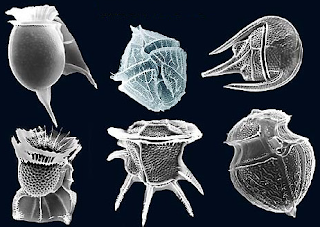Batrachospermum Occurrence:- (1) Batrachospermum is fresh water alga. (2) It is found in clear, cool, and running streams. (3) Deepwater plants are dark violet or reddish in color. But the shallow-water species are olive green. (4) The intensity of light changes the color of pigments. (5) The thallus is attached to the substratum. Vegetative structure (1) The thallus of an adult plant is soft, thick, filamentous. (2) It is freely branched and gelatinous. (3) The central axis is made up of a single row of large cells. Whorls of branches of limited growth are developed on this axis. (4) These branches are filamentous and dichotomously arranged. (5) The main axis is corticated. It consists of a row of elongated cylindrical cells....
Kingdom Protista
Characteristics:-
(1) Eukaryotic and Unicellular or Multicellular.
(2) Protista has no definite boundary due to similar characters with Algae, Fungi, and Animals.
(3) In many cases, Protista has no definite cell wall, so it resembles with Animals.
(4) In some cases, it has a cell wall made up of cellulose
(5) For reproduction, it will form sporangia characters of fungi.
Kingdom Protista divided into the following classes:-
(1) Dinoflagellates
(2) Diatoms
(3) Eugenides
(4) Slime Moulds
(5) Protozoans.
Diatoms:-
(1) They are also called Crysophytes contain Beta-carotene and chlorophyll-a.
(2) Cell wall forms by Mannitol, Lamiran starch, and oil.
(3) A cell wall composed of So2 and diatoms cell wall is Indestructible.
(4) Some Diatoms combine and form Frustle and Kisselghaur by its dead body.
(5) The shape of the Diatoms is like a soap-box.
(6) A large part of the soapbox is called Epithet.
(7) The smaller part is called Hyptothet.
(8) Continuous and passively floating in the water without flagella and cilia.
Asexual Reproduction:-
Binary Fission
Auxospore (Spore formation).
Dinoflagellates (phyrophytes):-
(1) Heterokont type 2 flagella.Transverse and verticle.
 |
| Dinoflagellates |
(2) 2-Layers are present outer -cellulose and inner-Pectin.
(3) It contains a,c and alpha-carotene.
(4) Mostly in Marine water.
Asexual Reproduction :-
(1) Spore formation
(2) Binary fission.
Sexual Reproduction:-
Isogamous.anisogamous and oogamous.
Euglenoids(Euglena):-
(1) Cell wall absent.
(2) Pellicle covers the body completely.
(3) Heterokont type of flagella present.
(4) Mixotrophic type of nutrition.
Mixotrophic -1. In the presence of light in show Autotrophic type and in the absence of light in show Heterotrophic type of nutrition.
 |
| Euglena |
(5) Sexual reproduction absent.
(6) Light detector present for autotrophic nutrition.
(7) Asexual reproduction by binay fission.
Cyanobacteria (Blue-green algae) forms Red sea e.g. Tricodesmium erythrium
Dinoflagellates from Red Tide e.g. Gonyalux.
Slime Moulds (Protistian fungi):-
Slime molds are also called Decomposers.
Acellular and cellular.
Acellular slime molds called Plasmodium and cellular called Myxamoeba.
Protozoans :-
(1) Locomotion Present.
(2) Cell wall absent.
Flagella :- e.g. Trypanosoma,Leshonin,Lesmania.
Cilia:- e.g. Paramecium
| Paramecium |
Sporozoites:-Spore forming e.g. Plasmodium vivax, falciparum, and ovale.
(3) Asexual reproduction by Binay fission.
Paramecium contains two nuclei Micro and Macro.
Micronucleus helps in reproduction.

Comments
Post a Comment
Thanks